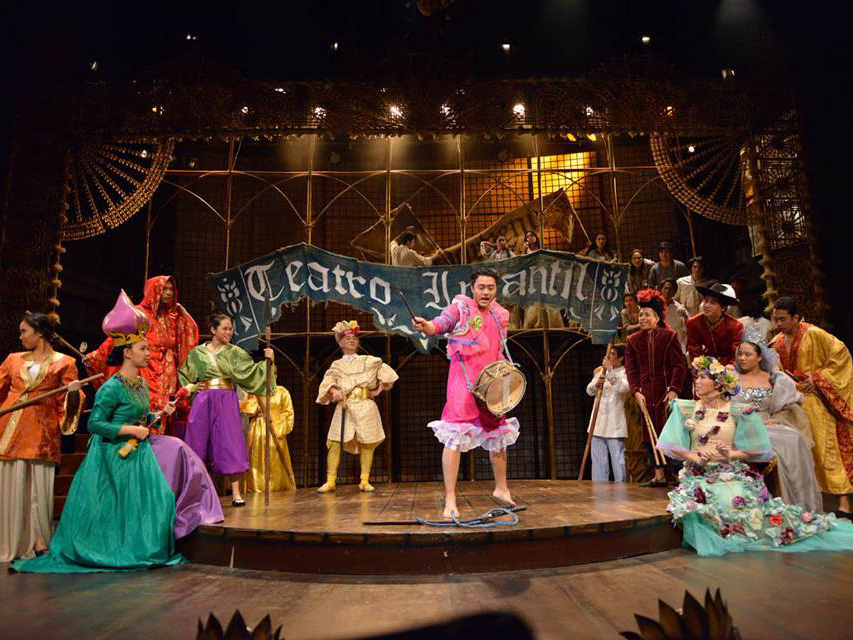Filtered by: Lifestyle
Lifestyle
Theater review: Of myths and memories in Dulaang UP's 'Teatro Porvenir'
By RINA ANGELA CORPUS

The official poster. Dulaang UP
“Teatro Porvenir” does exactly this, as it draws upon both myth and historical memory in re-living the memory of our revolutionary heroes as thespians.
Dulaang UP’s offering for Andres Bonifacio’s sesquicentennial, Teatro Porvenir was written by Palanca-winning playwright Tim Dacanay, who partially based it on historical accounts by Teodoro Agoncillo. Agoncillo once interviewed a Katipunero named Guillermo Masangkay, who recounted that Bonifacio and his brothers were once part of a moro-moro troupe named Teatro Porvenir—just before they helped found the revolutionary movement of the Katipunan. (“Porvenir” is Spanish for ‘future’, hence, “Theater for the Future.”) In fact, a quick check with popular references interestingly accounts for Bonifacio as a part-time theater actor, besides earning his keep as a bodegero: a very revealing piece of information about the hero’s artistic inclinations that is not very well-known, or even mentioned, in history books or classes.
Liberties: Heroes as actors
The late Agoncillo further opined in interviews that Bonifacio did not so much get his radical ideas from Euro-American books as much from his engagements as a theater actor with the subversive komedya or moro-moro plays that quietly attacked the Spanish colonial authorities.
Teatro Porvenir thus stands out for its astute re-framing of how Andres, Macario Sakay, and Aurelio Tolentino would have been as theater actors and incognito subversives of their time—passionate men of the arts as well as of the revolution.
Macario, in fact, was one of the Katipunan’s founding members, and just before that, was also a moro-moro actor like Andres. Aurelio, also fondly called “Ilyong,” was a playwright who also joined and supported Bonifacio in the Katipunan. This triumvirate of heroes then became the focus of this theatrical endeavor.

A cast picture. Dulaang UP
Both Dacanay and director Alex Cortez took liberties in re-fashioning the sensibilities of the period, as they also included Emilio Jacinto as a supporting character. Known as the brains of the Katipunan, Jacinto joined the movement as a college student, and though we see Jacinto in the play also rehearsing as an actor in the moro-moro of Bonifacio and company, no historical records actually confirm this ever having taken place.
These liberties, Dacanay noted in the program notes, were taken “to make the story richer and more accessible to the audience.” Dacanay further culled from previous plays and literary works related to the Supremo and the 1896 revolution, including actual poems by Bonifacio, Rizal, and Gregoria de Jesus’ letter to Jacinto.
Skilled portrayals

The three actors who eventually become revolution leaders. Dulaang UP
One of the more compelling moments in the play was a heartrending soliloquy towards the end, alternately spoken by Andres and Gregoria. While Andres recounted his struggle following his treacherous conviction by his own men, Oryang would take her turn to speak of her long-winded search for Andres and his brothers’ remains after their deaths by the hands of deceitful comrades.
Andres was alternately played by TV actor Romnick Sarmenta and Tanghalang Pilipino’s Russell Legaspi. Legaspi proved to be a strong character actor, the force of his demeanor readily giving life to the charisma and leadership that we associate with Andres.
Macario was vigorously played by Jojit Lorenzo, showing him as a street-smart patriot; while Aurelio was essayed by Joel Saracho, who expressively used a thick Kapangpangan accent, truthful to the playwright’s roots in Pampanga province.
Paul Paule also stood out in his heartfelt portrayal of Jacinto, and among the minor characters, UP student Ferdinand Angeles shone through with a natural, silver-tongued humor that gave comical life to his various roles as sacristan, mayor, and friar.
Hope springs eternal
Offering a vivid backdrop to the play was Faust Peneyra’s set design, as he made use of the singkaban, a beautifully-set bamboo arch that traditionally decorates the entrances of barangays that celebrate Philippine fiestas. The entire stage was enframed in a huge singkaban, while capiz shells, reminiscent of old Tagalog houses, were also used generously in the scenes. The traditional Filipino martial art arnis, meantime, was employed in the actors’ movement vocabulary, adding an apt nationalist and local reference to the show.

A moro-moro scene. Frances Makil Ignacio
Finally, a radiance of hope springs eternal in the arts. Even though the ending portrayed the tragic death and betrayals of Andres and Sakay, thus damaging the revolutionary movement, Aurelio lived on in real life. For it was Aurelio, the romantic and radical dramatist who outlived the other unsung heroes of his generation, who was able to write nationalist plays even after the demise of the main leaders of the Katipunan.
Saracho, in playing Aurelio, had noticeably profound tears in his eyes as he spoke the final indelible lines: “Tayo ang teatro na nagbibigay ng liwanag. Ngayon, hindi na kayo makakatakas sa akin, Andres, Macario, Emilio, Gregoria. Kayo ang magiging karakter ng aking mga dula.” (This is the theater that will give enlightenment. Now, you cannot escape from me, Andres, Macario, Emilio, Gregoria. You will be the characters of my plays.)
And finally, in unison, the entire cast of Teatro Porvenir ardently recited the last verse: “Bumabangon sa libingan ang bangkay ng aming bayan.” (Our nation’s remains know how to rise above the dead.)
Drawing richly from our historic past, Teatro Porvenir engages both the discourse of the revolution and the power of the arts in inspiring lasting freedoms. — VC, GMA News
Teatro Porvenir is now showing at the UP Diliman Ma. Guerrero Theater from Nov. 20 to Dec. 8, 2013. For ticket information, call Dulaang UP at 926-1349 or 433-7840.
All photos taken from the Dulaang UP Facebook page
Tags: teatroporvenir, theaterreview
More Videos
Most Popular




